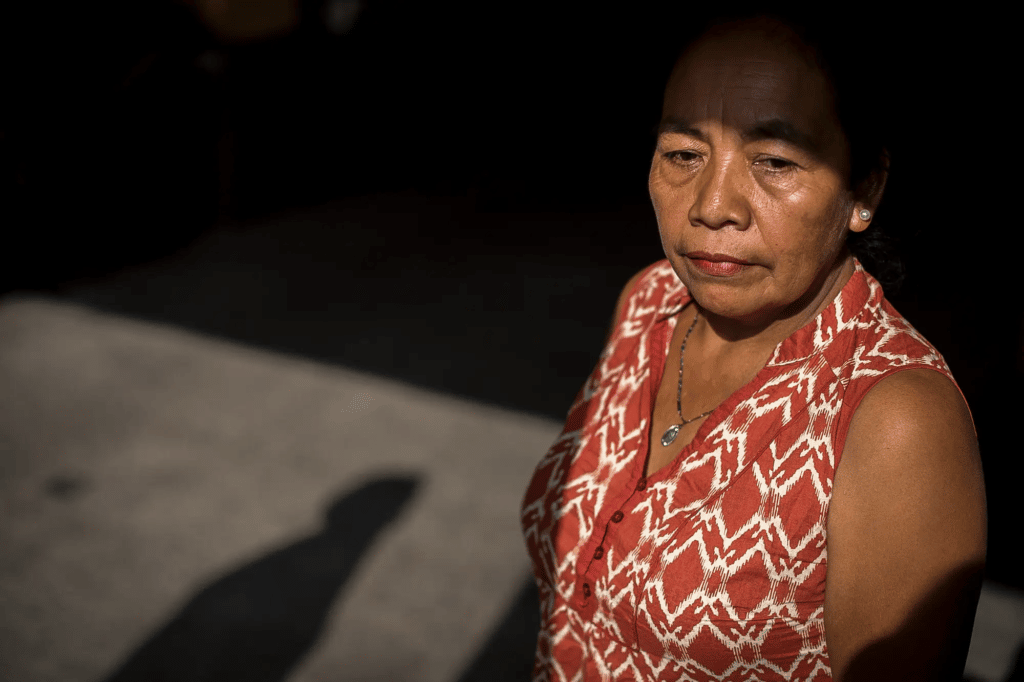As we look back at 2021, what world events do you remember the best? Was it Jeff Bezos and Elon Musk’s space flights? Or maybe it was Oprah Winfrey’s interview with Prince Harry and Meghan Markle. While these were some of the most popular headlines this past year, our Charity Alliance partner CARE took the opportunity to shine light on the year’s most important yet under-reported humanitarian crises in 2021. Global Impact’s Standing Emergency Response Fund supports our member charities like CARE responding on the ground to the next natural disaster or humanitarian crisis. Read the 10 most under-reported humanitarian crises of 2021 from CARE below:
Introduction
“A hurricane of humanitarian crises” is raging around the world, said UN Secretary-General António Guterres in the summer of 2021, as the number of people in need of humanitarian assistance reached an all-time high. Not only does this mean immense suffering for millions of civilians across the globe, but it is also stretching the resources of the United Nations and aid organizations to the limit.
A hurricane of humanitarian crises: the reference to extreme weather is particularly pertinent. The accelerating climate crisis is fuelling many of the emergencies we are seeing around the world, including 7 out of the 10 crises featured in this report. And there is deep injustice at the heart of it. The world’s poorest are bearing the brunt of climate change – poverty, migration, hunger, gender inequality and ever more scarce resources – despite having done the least to cause it. Add COVID-19 into the mix and we see decades of progress towards tackling inequality, poverty, conflict and hunger disappearing before our eyes.
As I write this, one in 28 people worldwide [1] are in need of lifesaving assistance, and there are over 84 million people displaced from their homes. [2] Despite this, last year the United Nations’ humanitarian aid was only funded by half, or $18 billion US dollars. Meanwhile, over $100 billion is spent worldwide every year on the arms trade. The European Union has stepped up to the challenge by increasing their budget for humanitarian aid for responding to crises and disasters. Here in the UK however, the government’s cuts to aid in 2021 have caused significant reductions in the FCDO’s budget, and resulted in over £166 million less in humanitarian aid reaching the 10 countries mentioned in this report compared to in 2019. [3]
Against this global backdrop, the sixth edition of “The World’s Most Under-Reported Crises” highlights the humanitarian crises that receive the least media coverage worldwide. Why is the public more interested in the billionaire’s space race than the fight for survival of millions of people around the world? The ongoing crisis in Syria – the second most widely reported humanitarian crisis after Afghanistan – still received less global online media coverage (230,000 articles) than the space flights of Elon Musk and Jeff Bezos (239,422 articles). While Zambia, where more than one million people are living with extreme hunger, was only covered in 512 reports compared with the announcement that Ben Affleck and Jennifer Lopez are dating again, resulting in 91,979 online articles globally.
The global prioritization of media coverage is astonishing to us and, as a humanitarian aid organization, CARE is dedicated to shining a light on the world’s neglected crises as well as providing much-needed assistance to those living through them. But what you may not realise is that your media consumption has a significant influence on what is reported and how much. Because it has never been so easy to measure media behaviour as precisely as it is today. When media coverage captures public attention, it can precipitate change. That’s why we want to focus attention on the emergencies and conflicts where humanitarian work can save lives and improve the situation. This report can only make a difference if it is read. Therefore, thank you very much for your interest.
Laurie Lee,
CEO of CARE International UK
Ten Humanitarian Crises That Didn’t Make the Headlines in 2021
Number of online articles between 1st January and 30th September 2021
- Zambia – 512
- Ukraine – 801
- Malawi – 832
- Central African Republic – 1,459
- Guatemala – 1,644
- Colombia – 2,136
- Burundi – 2,265
- Niger – 2,774
- Zimbabwe – 2,803
- Honduras – 3,920
In comparison…
- Online articles about space flights from Jeff Bezos and Elon Musk – 239,422
- Online articles on the interview of Harry & Meghan with Oprah Winfrey – 362,522
- Online articles about working from home – 1,636,992
- Online articles about the UEFA European Football Championship – 515,158
- Online articles about the Olympic Games in Tokyo – 3,537,062

1. Zambia
Climate crisis fuels the hunger crisis
Zambia, in Southern Africa, is known for its impressive and diverse flora and fauna, such as the Victoria Falls. These separate Zambia from the neighbouring state of Zimbabwe and were declared a UNESCO World Heritage Site in 1989. Although the landlocked country, with a population of almost 18.4 million people [1], has the status of a middle- income nation, almost 60 percent of Zambians live below the international poverty line of $1.90 USD per day. [2] People in rural areas make up the majority of those living in poverty, and are also the ones predominantly experiencing hunger and the most severe impacts of climate change.
Acute food insecurity
Like many other countries in Southern Africa, Zambia has been affected by prolonged droughts, resulting in a wave of food insecurity. Malnutrition rates in the country remain among the highest in the world. According to the latest results of an Integrated Food Security Phase Classification (IPC) analysis, approximately 1.18 million people in Zambia faced high levels of acute food insecurity between July and September 2021. [3]
Although the 2021 harvest was good, a combination of flooding between December 2020 and February 2021, rising corn prices, and parasites such as the African migratory locust and fall armyworm contributed to acute food insecurity. COVID-19 is also doing its part: in the period from January 2020 to October 2021, 3,660 people had already lost their lives due to Coronavirus. [4] Vaccine supply is slow. As recently as July 2021, Zambia was struggling with its third wave of infections. The pandemic is having a particularly negative impact on the economy. The population has suffered significant income losses, which has only exacerbated difficulties in accessing food.
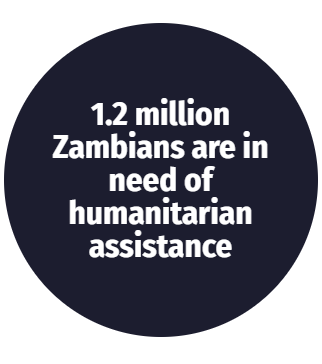
Poverty in Zambia is female
Gender inequality is one of the country’s main problems, affecting poverty and food insecurity. Women make up about 51 percent of the rural population in Zambia. [5] Poverty rates in households headed by women are generally higher than those headed by men. This occurs even though women are the main actors in food production and processing in Zambia: 60 percent of the national food supply is produced by women. [6] Gender equality and women’s empowerment are thus even more important in achieving food and nutrition security, rural poverty reduction, and sustainable development for all, according to the Government of Zambia and the Food and Agriculture Organisation of the United Nations.
Currently CARE Zambia is partnering with government departments such as agriculture, livestock, chiefs’ affairs, community development and social services, forestry, water resources and local government to build sustainability of the entire landscape management. This is possible through systems which help build livelihoods that are resilient to climate change. CARE is also strengthening community structures to ensure participation of women and girls in decision-making and access to resources and services. They do this through community-based adaptation approaches by working with Farmer Field Business Schools approaches (FFBS) and Social Analysis and Action (SAA). Currently CARE is implementing these projects in Gwembe and Kalomo districts in the southern province, which are among the most vulnerable districts to cyclic drought. CARE is also working in Mpika, Chinsali, Isoka (Muchinga province), Monze and Choma (Southern province), as well as in Lundazi and Chipata districts (Eastern province) on food and nutrition security with funding from the United Nations.
Women and girls at the heart of CARE’s work
CARE began operating in Zambia in 1992 in response to severe regional drought and extreme poverty. Today, the priority is long-term, community-based development programmes that operate in both rural and marginal peri-urban areas. CARE Zambia’s core focus is empowering women and girls, who bear the brunt of poverty and crisis, through maternal and child nutrition and social protection. Working with communities and policymakers, CARE continues the fight against poverty in Zambia and is committed to gender equality and greater, more meaningful participation of people living with HIV and AIDS.
2. Ukraine
Conflict and COVID-19
Eight years into the armed conflict in eastern Ukraine, the impact on the lives of millions of people in the Donetsk and Luhansk regions has been significant. According to estimates by the United Nations, around 3.4 million people were specifically in need of humanitarian assistance and protection in 2021. 68 percent are children and women, and 38 percent are elderly. [7]
Although last summer’s temporary ceasefire marked
the longest “respite” since the conflict began, one can hardly speak of an “end”. Hostilities continued to rise and, in January 2021, the first attack on an educational institution and the first civilian fatality since establishing a ceasefire was recorded. And it did not stop there: between January and September of this year, the UN reported 15 civilian deaths, 60 people injured, and 265 private homes damaged. [8]
While a comprehensive political solution for the conflict is still not in sight, people in eastern Ukraine are daily forced to put their lives on the line. Along the 420-kilometre “contact line” that separates Ukrainian government- controlled territory from that of the separatists, the situation is particularly dangerous. Fear of gunfire, violent encounters and the threat of landmines and explosive war munitions remnants are sadly part of everyday life for those on both sides. Access to livelihood resources and services is limited and opportunities for employment are almost non-existent.
COVID-19 as a crisis amplifier
COVID-19 and its impacts further complicate the situation for affected people in the region and exacerbate humanitarian needs. The pandemic has brought Ukraine’s already weakened health care system and shrinking, regional economy to the brink of collapse. In the early months of the pandemic, all border crossings along the “line of contact” were closed to contain the virus, severely restricting people’s movement. For the vulnerable population, especially the elderly and people with disabilities living in areas outside government control, main sources of income such as pensions and social benefits are hardly available. Often, there is just enough money left over for food. COVID-19 is also having negative effects on mental health, with many people struggling to maintain family ties as a result of measures taken to combat the spread of the virus.

Women bear the brunt
Gender-based violence, exploitation, discrimination, and poor access to vital health services: as in many other parts of the world, it is Ukrainian women who are most affected by the crisis in their country. For example, pregnant and breastfeeding women continue to lack unrestricted access to sexual and reproductive health services, such as prenatal and postnatal care or safe childbirth options. The long-running conflict has also increased the risk of human trafficking – women and girls are exploited primarily for sex work. Unwanted pregnancies, abortions and an increased risk of contracting sexually transmitted infections are the result.
The war in Ukraine flares up over and over again and therefore receives more attention in the media for short periods of time. The last time this happened was in December 2021. Please note that the global media analysis in this report covers the period of 1st January 2021 to 30th September 2021. Further details on the methodology can be found below.

3. Malawi
On the frontlines of the climate crisis
Malawi is one of the countries where the full impact of the climate crisis can already be felt. Extreme weather events such as droughts, floods and landslides will continue to increase over the next few years. The result? Infertile soil, destroyed harvests and severe famine.
In 2019, tropical storm Idai swept across the country. The widespread flooding destroyed many fertile fields just a few weeks before the start of the harvest season. Two years after this disaster, countless families are still suffering from the effects. For many of the 80,000 people9 who lost their homes back then, normality is still a foreign word. “Unfortunately, climate-related disasters are expected to increase in frequency and severity in the coming years. The range of events, such as drought, tropical storms and soil erosion, make adaptation to the changed climatic conditions even more difficult. Around 40,000 people [10] will therefore be forced to flee to other parts of the country every year.
Measures to adapt to the climate crisis, such as new water systems or more resistant seeds, are expensive. For many people in Malawi, this is simply not affordable. Nearly 70 percent of the population must survive on less than $1.90 USD [11] per day. Climate change is hitting them earlier and much harder than people in the global North. More than one million people are [12] affected by extreme food insecurity and 39 percent [13] of children up to the age of five are underdeveloped due to malnutrition. The situation is particularly serious in the many rural regions.
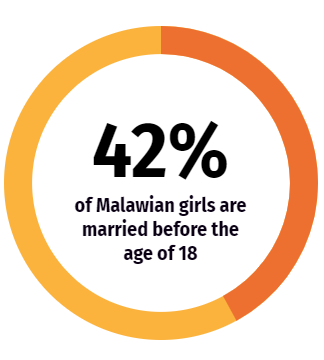
Malawi ranks 174 out of 189 countries on the Human Development Index (HDI). [14] Nearly half of all children do not even finish primary school. The average life expectancy is 65 years. [15] The COVID-19 vaccination campaign is off to a slow start. A vanishingly small number of doses have been administered so far. Vaccinating the total population of Malawi, 19.3 million people, will be a massive challenge. [16] In addition, there is a high number of HIV infections. According to estimates, almost 10 percent of the total population is infected, including many children.
In Malawi, CARE is committed to tackling food insecurity and inequality. CARE works to ensure people can earn a decent living and access food, medicines and information about health risks such as HIV. CARE also helps to strengthen democratic structures in close cooperation with the government and supports those affected by climate- induced disasters with emergency aid and reconstruction measures.
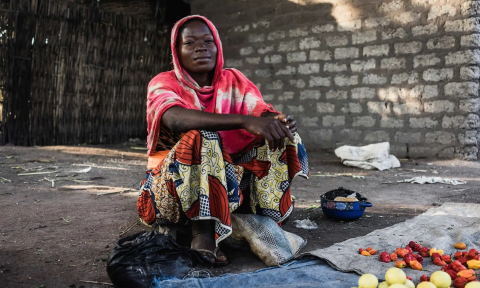
4. Central African Republic
A long road to peace
In October 2021, the president of the Central African Republic and leaders of various rebel groups agreed to a ceasefire, [19] ending a civil war that had been going on for a long time. This is hope for a country that has not been able to come to rest for years. Hope as well for the more than 700,000 people who are displaced in their own country – more than half of them children. [20]
A peace agreement was signed back in February 2019, however only a few months later the conflict flared up again. The civilian population was caught between the front lines. Attacks, kidnappings and human rights violations were the order of the day. The situation became particularly dramatic in December 2020, when armed groups used violence to try to prevent the upcoming presidential election. Once again, many families were forced to flee and more than 100,000 people [21] began their journey to neighboring countries. Targeted attacks on essential infrastructure, such as bridges and roads, impeded essential food supply.

2.3 million people [22], just under half the population, are affected by massive food insecurity. This means they do not have access to sufficient and balanced food. This dramatic situation is a direct result of the violent conflicts throughout the country: families are losing access to their fields and thus the ability to grow their own food. The spike in violence around the presidential election in December 2020 coincided with harvest time. The result was low yields and nearly empty stocks. Add COVID-19 to that. In many cases, measures to contain the virus have further reduced family incomes. This, combined with higher food prices, has drastically increased the risk of malnutrition among the population.
The civil war in the Central African Republic has had far- reaching impact on most of the population. In the Human Development Index (HDI), the country ranks second to last globally. On average, a child attends school for just under [23] four years, and girls for only three. At the same time, child labour continues to be a massive problem. Almost one-third of all children are affected [24], with the number of unreported cases potentially much higher. Still, numerous families see no other way out. More than 80 percent of the working population earns less than $3.20 USD per day. [25] This is not enough to sustain an entire family. For long-term and positive development, stable peace is a prerequisite. The United Nations Development Programme (UNDP) shares this view and invests just under three quarters [26] of its budget for the Central African Republic in projects related to Sustainable Development Goal (SDG) 16 – promotion of peace, justice and strong institutions.
CARE assists families in southern Chad who have fled violence in the Central African Republic [27]. They urgently need access to water and food, as well as shelter and protection from sexual and gender-based violence. CARE provides rapid assistance and supports people to return to a self-determined life in the long term.
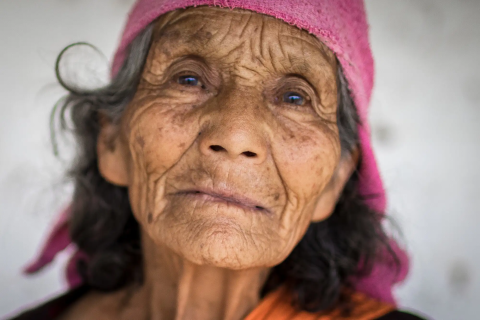
5. Guatemala
Poverty, violence and climate crisis
Guatemala is located on the narrow land bridge that connects North and South America. Its location makes it one of the countries on the route of many migrants heading towards Mexico and the United States. Between August 22nd and October 12th 2021 alone, 14,108 undocumented migrants and asylum seekers from El Salvador, Honduras, and Nicaragua were sent back from Mexico to the border town of El Ceibo in northern Guatemala. Migrant shelters are overcrowded, leaving many living on the streets and subject to attacks by criminal groups. Those turned away at the border will usually make further attempts to enter the United States through Mexico. [31]
Guatemala has one of the largest economies in the region, with a population of 16.9 million. However, at the same time, social inequality in the country is enormous, and it is considered one of the most dangerous countries in the world. In 2020, 3,500 murders were reported. The widespread violence in Guatemala and its Central American neighbours pose a high risk for many everyday situations and errands – especially for women. By August 2021, femicides had increased by 31 percent. Although about 3.3 million people in the country rely on humanitarian aid, the frequent occurrence of violence is in many cases a barrier to accessing urgently needed assistance. [32]
Guatemala’s population is multicultural. Around 40 percent of its inhabitants are indigenous Maya. And despite middle- income status according to the World Bank, two-thirds of the population must live on less than $2 USD per day.
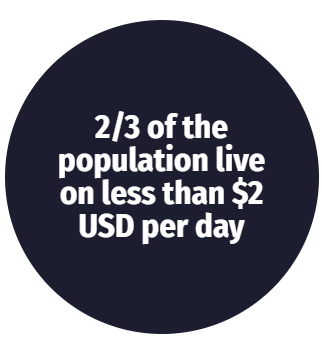
Among the indigenous population, the proportion of people affected by poverty is about 79 percent, with 40 percent living in extreme poverty. Among them are a particularly large number of women. Nowhere in the region is social inequality between genders greater than in Guatemala. [33]
A driving factor of poverty is the impact of climate change. Guatemala is one of the ten countries in the world most vulnerable to climate change, and one of the most affected by climate-related disasters in the region. [34] In the eastern and western parts of the country, prolonged seasonal drought in recent years has repeatedly led to harvest losses of staple crops. To compensate for the shortfalls in corn and beans, people have had to resort to imported food, which eats up their income and means, and leads to a deepening food security crisis. According to projections by the IPC (the International Hunger Early Warning System, in which CARE participates), an estimated 6.5 million people – or about 38 percent of Guatemala’s total population – will be affected by a food security crisis (IPC 3) or emergency (IPC 4) in 2018-2023. [35]
CARE has been working in Guatemala since 1959. In addition to improving food supplies, CARE and its local partners are committed to reducing the vulnerability of women, youth and their families to crises by increasing their resilience
to poverty, violence and the consequences of climate change. CARE works to ensure that women and girls from indigenous and rural communities can enjoy and exercise their human rights. A life free from violence and racial and gender discrimination is the declared goal. Central to this is the economic empowerment of women, which contributes to social equality between women and men. [36]
To address these issues, CARE Guatemala coordinates with partners, such as La Casa del Migrante, Integral Support Centers for Women Survivors of Violence and CAIMUS, as well as with local organizations, like Center for Research, Training and Support for Women and Youth and CICAM, all of which work tirelessly for the rights of the people they serve.

6. Colombia
Not all problems disappear with peace
Peace has prevailed in Colombia since 2016. After five decades of civil war, the country has since come to a certain degree of calm. Economic progress has also been clearly visible in recent years. Nevertheless, the humanitarian situation remains worrying. In some remote and rural regions of the country, criminal and paramilitary organizations continue to cause violence and simmering conflicts.
Moreover, the COVID-19 pandemic has caused an economic recession throughout the country. Food insecurity is the result for some segments of the population, particularly indigenous groups, internally displaced persons and the more than 1.8 million refugees from neighbouring Venezuela who have primarily taken shelter in northern Colombia.
According to the United Nations Office for the Coordination of Humanitarian Affairs (OCHA), there were 6.7 million people in need of humanitarian assistance in Colombia in 2021 – including around 2.3 million children and 2.3 million people from minoritised ethnic groups. As recently as last year, 2020, the number of those in need of humanitarian assistance was reported to be at 5.1 million. Especially alarming is that according to the United Nations, 4.9 million people in Colombia live under the influence of armed and criminal groups.

The situation has worsened particularly in the regions along the border with Venezuela. There, criminal groups fight for control of land, oil and the drug trade at the expense of the population. Human trafficking, murders and other violent crimes have increased sharply. Women and girls are particularly affected by violence. Humanitarian and medical services for women and girls are completely inadequate. [37]
Two out of three women have experienced abuse
In September 2021, CARE conducted interviews with Colombian and Venezuelan migrant women in the city of Ocaña, which has a population of around 100,000 people and is home to more than 40,000 refugees and displaced persons. Approximately 90 percent of the respondents met the criteria for enrollment in programs to address violence against women and girls and cash assistance. 71 percent had already experienced physical abuse. About 70 percent reported threats, intimidation, and other forms of psychological abuse. 56 percent reported having already experienced financial extortion by partners and relatives with the aim of keeping them in violent relationships. [38]
CARE responds to the humanitarian crisis in the country directly and works through local partners, such as Corprodinco, and particularly women’s organizations, to ensure a sustainable and localised approach. In its projects, CARE focuses on the vulnerable population, displaced persons and refugees, and especially on women, youth, and the LGBTQIA+ community. CARE works with a mainstreamed gender approach on sexual and reproductive health, protection with a focus on gender-based violence response, water, sanitation and hygiene, livelihoods, and cross- cutting cash assistance. [39]
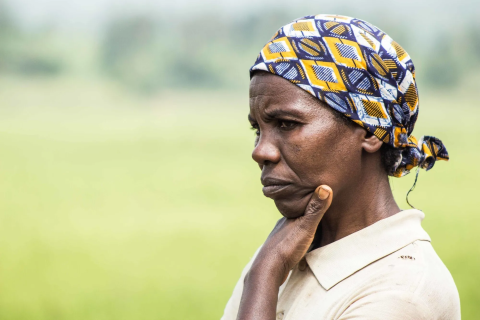
7. Burundi
Permanent crisis without headlines
Burundi is an “old acquaintance” on CARE’s list of the world’s most under-reported crises. Last year, the East African country was ranked Number 1 and in three of the four previous editions of “The 10 Most Under-Reported Humanitarian Crises” it made the top 10.
12.6 million people live in Burundi, of which 2.3 million needed humanitarian aid in 2021. [40] From extreme weather events and hunger to political unrest and refugee movements, the people of Burundi face many challenges. And yet one hears very little from this region in the world.
During the rainy season in spring 2021, lakes and rivers overflowed their banks. A total of 50,000 people were affected by the floods, and 20,000 had to leave their homes. There had already been severe flooding in the previous year as well. Humanitarian relief efforts were initiated, but the Humanitarian Response Plan for Burundi was only 15 percent funded at the time. [41]
Climate crisis means hunger
In Burundi, 90 percent of the population lives from small-scale agriculture. Yet only a third of the country’s land is suitable for agricultural cultivation. [42] Extreme weather events, such as droughts, floods, and landslides, damage the soil, which is already strained by intensive agriculture. While we in the global North are still discussing energy prices and the “costs of climate protection”, the facts in Burundi are crystal clear: more than 80 percent of the people who are currently internally displaced have hadto flee due to climate events. The climate crisis is already costing countless people in Burundi their homes. [43]
The COVID-19 pandemic also continues to have an impact. According to official figures, only around 20,000 COVID-19 cases were confirmed in the country in 2021. [44] However, the number of unreported cases is probably a lot higher, due to the small quantity of testing. It was not until October 2021 that the public vaccination campaign in Burundi was launched. Burundi, alongside Eritrea and North Korea, was one of a few countries worldwide that had not yet organized vaccinations. [45] The government as well as the population remain very skeptical about the vaccines.
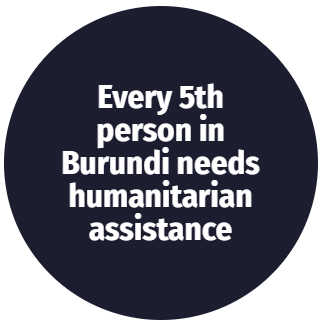
Structural discrimination against women
Women and girls are confronted with unequal opportunities and rights every day: 60 percent of the agricultural workforce are women. Yet only 20 percent of members in local decision-making bodies are female. The birth rate in Burundi averages five children, and only 20 percent of women have access to family planning methods. One in three women in Burundi has experienced intimate partner violence in the past year, and 13 percent of girls are married before the age of 18. [46]
CARE has been working in Burundi since 1994, initially with emergency relief interventions (food, non-food supplies, and shelter) for people affected by civil unrest. Today, CARE focuses on sharing knowledge and capacities with Burundian civil society partner organizations. The aim being to support, creatively and at scale, the resilience and transformation of communities that are most vulnerable to climate change and the socio-economic aftermath of the COVID-19 pandemic. In total, CARE has ongoing partnership agreements with a dozen organizations in Burundi. With six of those organizations, CARE Burundi has a standing agreement for emergency preparedness and response. Women and youth are the focus of all projects. The foundation of CARE’s support is the mobilisation and strengthening of self-managed savings groups, and the provision of trainings in entrepreneurship and positive gender societal norms. With CARE and the support of partners, vulnerable groups are able to earn reliable income themselves and reinvest some of that income for greater resilience and growth. CARE specifically supports social services and infrastructure, such as water supply, health, and food security. In addition, CARE works with leadership structures in communities and in public institutions in support of equal opportunities and rights for men and women. The ultimate vision being to advance cohesive and gender-just communities, free from social injustice and poverty.
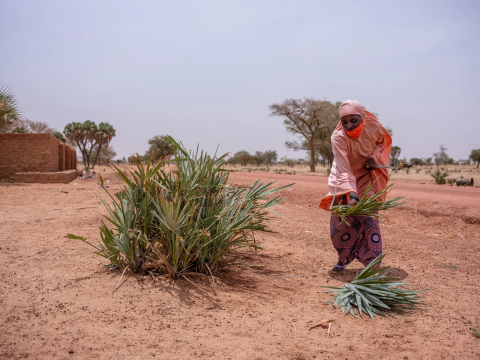
8. Niger
Weather extremes and violence threaten survival
Endless sand and merciless sun: conditions are increasingly tough for the people of Niger in the Sahel. For centuries, what the soil produced has been just enough to survive, but this is ending now: the climate crisis is destroying livelihoods and conflicts are making entire regions unsafe.
Niger is one of the most climate-vulnerable countries in the world, already severely affected by persistent droughts and recurring floods. The devastating impacts of climate change, combined with increased proliferation of armed groups in the East and North, pose a large threat to the country’s economic stability and overall resilience. The result is widespread food insecurity, malnutrition and displacement, with 2.9 million people currently in need of humanitarian assistance. And this has been the case for many years: Niger and the Lake Chad region are on the top 10 list of under-reported crises for the fifth time. [47]
In Niger, 80 percent of its approximately 25 million inhabitants live in rural areas. [48] The impacts of climate change alternate between severe floods and prolonged droughts, which always mean loss of harvests. In August, yet another flood drove two million people into food insecurity. More than 1.8 million children are dependent on nutritional aid. [49] 45.7 percent of children between the age of six months and five years suffer from chronic malnutrition, which endangers their development. [50] A severe outbreak of cholera in the regions of Dosso, Maradi and Zinder further exacerbates the situation. [51]
For years there has also been a violent conflict between non-state armed groups and national and international armed forces in the Central Sahel. In 2012 the conflict had spread to the Nigerien regions of Diffa, Tahoua and Tillabéri. [52] Many people are now fleeing violence and seeking protection elsewhere. September 2021 registered a total of 313,000 internally displaced persons. [53]

Providing emergency relief is often hindered by the fact that infrastructure is destroyed, operation areas are marked by violence and rural areas are difficult to access. As of November 2021, only 26 percent of the $523.2 million USD needed to cope with the crisis had been made available. [54]
In Niger, CARE supports communities affected by conflict and food insecurity through projects aiming for the long- term stabilisation of the region. Together with its local project partner HED-Tamat, CARE sensitises young people to the dangers of extremist movements and provides training in conflict resolution techniques. [55] In the high-risk area of the “Trois frontiers” between Mali, Burkina Faso and Niger, CARE works with HED-Tamat to provide long-term support to people in protracted emergency situations. They use the triple nexus approach, which aims to address immediate needs and build affected people’s livelihoods, while at the same time working on peace building for social cohesion.
To build resilience among people affected by small onset crisis (especially due to localised droughts), CARE partnered with the World Food Programme (WFP) to implement a resilience project in the Maradi, Zinder and Diffa regions, which has reached more than 19,420 households. This project supports livelihoods by providing food or cash assets and helps to support girls at school with different measures, including scholarships. Overall CARE Niger’s humanitarian response reached more than 23,000 households and 156,030 people in 2020.
30 years ago, CARE founded self-managing small savings groups in Niger, mostly involving women. Group members save their money as a community and enable each other to access loans and emergency assistance. As well as independence, group members also gain a voice: 78 percent of women who are organized in a small savings group in Niger are also actively involved in public decision-making processes that affect their own living environment. [56]
20 percent of Niger’s population are nomadic communities, who are particularly vulnerable to extreme weather conditions as they traditionally raise livestock and follow seasonal rains. CARE supports communities with transportable containers for planting vegetables; a cultivation method that is independent of the weather and provides nutritious food for their families. [57]

9. Zimbabwe
A third of the population are hungry
It is a sad premiere: for the first time Zimbabwe is listed in the top 10 most under-reported crises. The landlocked country in Southern Africa is known to many for its impressive natural spectacle, the Victoria Falls. Far less international attention is paid to the country’s acute food insecurity and extreme climate conditions. Zimbabwe has also been in a deep economic crisis since 2008, which was further exacerbated by the COVID-19 pandemic. [58]
The consequences of the climate crisis are already visible in Zimbabwe: the frequency and intensity of climate- related disasters such as droughts, floods and storms have increased significantly. [59] The harvests in many rural areas are not sufficient to secure basic food supplies and other needs. In these regions, households must rely on local markets when supplies are depleted – but the prices there are unaffordable for many. Zimbabwe has an agriculture- based economy which drives local markets at all levels. The water crisis goes beyond thirst and has a negative impact on surface and underground water access for multipurpose use and, most importantly, for agricultural production.
This is reducing crop and livestock production levels. High numbers of livestock deaths have been recorded between 2017 and 2021 due to El Niño.
The food situation is also strained in the cities. Many people lost their livelihoods due to COVID-19 containment measures, which caused smaller shops to close, imposed curfews and restricted imports and exports. As a result, household income fell by 50 percent. [60] 65 percent of the informal workers affected are women, who therefore faced disproportionate economic hardship. [61] Faced with low incomes and above-average prices, many households are on the brink of survival. Recently, the number of people lacking food rose to 5.7 million, or more than a third of the population. [62] Compared to the figures before COVID-19, a worrying 200 percent increase in cases of gender-based violence was recorded. [63] It is not only women who are suffering from the current situation in the country, but also children.

More than 4.5 million children and adolescents were unable to attend school for extended periods of time during the pandemic and thus did not receive any school meals. As the living situation of families worsen, cases of child labour and early marriage are increasing significantly. [64] Particularly for girls, the chances of returning to school are poor as long as their families are in dire need. To support the population, CARE distributes cash and vouchers to particularly vulnerable households so they can purchase food during the dry season. This includes the vulnerable urban communities mentioned previously. In total, around 50,000 people have been assisted in this way. Other programmes focuses on building resilience and enhancing the transformative capacities of communities so they can better cope with climatic shocks and stresses. CARE has also built and strengthened partnerships with crop research institutions to invest in climate smart crop production, seed multiplication and multi-hazard assessments.
In addition, a system of protection against sexual abuse and early detection of malnutrition was developed. [65] Together with local organizations, CARE is also working on mechanisms to improve disaster management. Here, the objective is to strengthen capacities at the local level to enable the affected population to react quickly. The question in Zimbabwe is not if, but when the next extreme weather event will occur. [66]

10. Honduras
Poverty and violence: two reasons to flee
A Caribbean coast with the finest sandy beaches in the north and the Pacific Ocean in the south. What sounds like a dream holiday destination is, for millions of people in Honduras, a difficult place to survive. Around 2.8 million people, almost a third of the population, are dependent on humanitarian aid in Central American Honduras. A large proportion of people lack food. According to a study from 2020, around 70 percent of the people in Honduras live in poverty. Many therefore no longer see any prospects in their homeland and flee in search of hope and a regular income in the direction of the United States. Hundreds of thousands of people are making their way across Central America, mostly on foot – and according to estimates, 90 percent of them come from Honduras.
Migration from Honduras has increased sharply in recent years. The country’s youth lack prospects, jobs and opportunities. The increasing crime rate and corruption in the country also cause many people to despair. Gang crime, fear and violence are part of everyday life. For years, Honduras has ranked among the top murder statistics in the world.
Young women and men often leave their home country with only a backpack and a few food items. The chronology of the escape is usually the same. First, people flee from the countryside to the cities to find work. However, since there are hardly any jobs there, they move on. They try to make it to the United States in order to earn a little money, which in turn is supposed to make ends meet for their families back home. In Honduras, people therefore often talk about poverty being female, as it is mostly women who stay behind with the children.
In addition, climate change is having a huge impact. Hurricanes, floods and drought in particular are causing livelihoods to deteriorate and considerable crop losses. Hurricanes, floods and drought in particular cause a significant deterioration of livelihoods and considerable crop losses. In autumn 2020, tropical storms Eta and Iota hit the population of Honduras particularly hard. A total of 937,000 people were displaced within the country due to disasters – the highest number in the whole of Latin America. The impact of the COVID-19 pandemic was added to this. Around 10,000 people (as of October 2021) have died from the virus in Honduras so far. Both pandemic and weather extremes have resulted in over three million people experiencing food insecurity. Women, children, people in informal work, indigenous groups, Afro-Hondurans, LGBTQIA+ groups and people with disabilities are the worst affected.
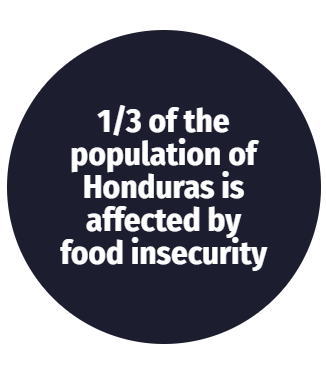
Gender inequity is an integral part of widespread social and cultural norms in Honduras. “For example, women must often give up their careers to take care of their children and household. As a result, men are hired twice as often as women. Women are also often denied access to male-dominated professions. If they do find work, they are paid less. Women’s economic participation has decreased, with thousands of women losing their incomes, jobs and livelihoods. This is because many of them work in the informal sector or are overrepresented in sectors severely affected by the prolonged closure of the economy (micro, small and medium enterprises, tourism, domestic workers, commerce).
Described as “one of the most dangerous places on earth for women”, Honduras is also home to rising gender-based violence. Statistics from 2021 (as of January to July) record a femicide every 29 hours in Honduras. In 2020 6.7 women per 100,000 inhabitants died violently, which is almost 50 percent more than in Latin America as a whole. Since 2017, the calls to the Emergency hotline (911) to report domestic violence and intrafamily violence have almost doubled. Since the pandemic, women’s rights organizations warn that the situation is only worsening.
CARE has been working in Honduras since 1954 to tackle poverty in the poorest communities. Programmes span across food security, health, nutrition, women’s economic justice and climate resilience. CARE Honduras also focuses on the individual and collective rights of women – working to strengthen economic opportunities and combat gender-based violence.
CARE Honduras prioritises working with women’s rights organizations in their territories of influence, such as MOMUCLA, a grassroots organization from Choloma. This municipality has high levels of crime and violence and was hit by hurricanes that resulted in hundreds of people losing their homes, belongings and livelihoods. MOMUCLA and CARE provide integral support for women at risk and survivors of gender-based violence, which includes economic recovery measures, psychosocial support, hygiene kits and gender- based violence prevention.
Recommendations
What can we do?
CARE has published this ranking for the sixth time in a row. Some countries are “permanent guests” on the list of crises that receive the least attention worldwide. Is there a lack of money? Interest? Knowledge? Humanitarian needs are again at a record high in 2022, with 274 million people in need of immediate survival assistance, or one in 28 people worldwide. The pandemic poses major challenges for governments and administrations, but it also reveals global injustice: access to vaccines, hunger, poverty, gender inequality, violence against women and girls, and care for the sick, which primarily falls on women and girls.
We asked a range of people for their recommendations. Voices from politics, the aid sector, CARE partner organizations and women from crisis-affected regions, who often struggle to be heard. They all have their own views about what we can do to shine a light on the world’s forgotten crises.
Concessa Nizigiyimana – Gatumba, Burundi
“My name is Concessa. I’m 38 years old and I live in Gaharawe, Gatumba, which is in West Burundi, near the border of the Democratic Republic of the Congo.
I have been affected by two crises that occurred in Gatumba since 2020. First, the floods, due to heavy rains, caused people to leave their destroyed houses. We had to go to camps for displaced persons, where we suffered from the cold, hunger and dirt. Secondly, we were faced with the closure of borders due to the COVID-19 pandemic. Since my livelihood was to trade across the border, it became very hard for me to feed my family. My children fell constantly ill as they were exposed to malnutrition and the cold.
I think that such crises need to be reported more broadly, both in my own country and abroad. When communities are able to tell what they are experiencing, we can work together with local authorities to ease the situation. CARE Burundi helped us quickly with an emergency response at the time. I also think that women and girls need to be heard much more. Their needs in a crisis may be different from men and boys.
Another way to ensure these crises are reported is the organization of a competition of innovative solution ideas, such as a ‘Hackathon,’ in order to contribute to the improvement of women’s health. This competition was a good measure for mobilisation, community awareness and decision makers. The competition targeted female members of the Village Savings and Loans Association (VSLA) and local social entrepreneurs. I believe that if the media works closely with the organizations, it will help raise effective awareness and engagement in the community, and therefore receive the needed support.”
Bernardina Cobox – Quetzaltenango, Guatemala – Project Transform Yourself, Women Free of Violence
“Generally, people talk about the violence that women suffer, but they don’t know how to listen to us and we don’t talk about it ourselves. We are afraid to be in the news, to be talked about and to have others tell us what we go through, because it is distorted and makes us the centre of ridicule and accusations. The news is manipulated, so we need conscientious allies who know how important it is for us to tell our own story, to call things by their name and to have spaces of solidarity.
Sometimes we want to cover the sun with a finger (hide the situation) and so does society. It is a power struggle, in which they continue to control what to say, because they are patriarchal and do not want to be found out. We live these crises every day, but they pass them off as something normal to the point that nobody talks about it anymore.
We could make so much noise that they will have to listen to us, they will pay attention to us and we will emerge from the silence.”
Omar Bizo – Niger – Manager of a local NGO: ADL – Appui au Développement Local (Support to Local Development)
“The decrease in budgets, the drop in advertising revenues and the reduced network of correspondents around the world have caused a void in the media coverage of crises. During a disaster, the media is more sensitive to the number of deaths than to the analysis and presentation of the underlying causes of the event.
The number of people in emergency situations will increase in the years to come and we cannot prioritize their suffering according to the number of deaths. For a media outlet to commit to devoting a certain percentage of airtime or space to covering these forgotten humanitarian crises would be an example of positive change.
This can also be done by sending a reporter each year to cover a forgotten crisis, by organizing a roundtable on a forgotten crisis that will be broadcast in the media, or by providing support in terms of skills or money to local journalists and media that are sometimes very poor.
NGOs try to compensate for the withdrawal of journalists from the field by proposing new content or by organizing press visits to condemn these humanitarian crises.
Young people are more and more concerned about the climate and humanitarian crises. They demand complete and reliable information but also more testimonies from the people directly concerned, via the media they use. They also want testimonies that bring hope and solutions, which is certainly not always possible, but requires trying to vary the angles of reporting.
We saw last year how a Swedish teenager turned a simple climate protest into a global movement of millions. With the rise of citizen journalism and people around the world taking to the streets to make their voices heard, there is no longer any doubt: every voice, every gesture counts and can help launch or strengthen a movement towards a more just and united world.
It is also up to us, actors of development from the global South, to let our colleagues in the field speak for us, who are often less solicited by the media but whose authenticity is a guarantee of credibility.”
Sofía Sprechmann Sineiro – Secretary General of CARE International
“This report holds a stark mirror up to the complex world we are all currently experiencing. Be it the immediate threat of the COVID-19 pandemic, the worsening climate crisis, or rising social injustice playing out across the world; audiences everywhere are experiencing high levels of stress and fatigue from an overwhelming and often very frightening news agenda. Add to this the ongoing battle with misinformation, fake news and harmful online behaviours, it is perhaps not surprising that many are simply switching off from bad news.
So how can we encourage audiences and, in turn, the media cycle, to pay attention to neglected humanitarian crises such as those highlighted in this report?
At CARE, we believe in championing locally-led solutions. We have a long history of working hand-in-hand with communities and civil society to support and scale workable interventions to poverty and hardship. We also believe in the power of sharing the stories of resilience and innovation that we come across in our work every day, particularly as media institutions and humanitarian organizations alike receive less and less funding. Engaging audiences globally with the realities of life across different seas and borders inspires solidarity and action. And never has this been more important or so easy to do. Thanks to mobile phones and ever-improving internet access, we are able to connect journalists, audiences and our supporters directly with the stories – and the storytellers – that matter most.
It is hard to not to be inspired and uplifted by the storytellers featured in this report; 16-year-old Litness in Malawi, or Raquel Vasquez, the climate champion in Guatemala, both making positive change happen in their communities despite the challenges of their daily lives. These are the stories of resilience, hope and opportunity that shine a light along the path towards a brighter future for us all. It’s time more of the world heard them.”
Janez Lenarčič – European Commissioner for Crisis Management at the European Commission
“Today, humanitarian needs stand at an all-time high, driven largely by the resurgence of state-based conflicts, combined with the impacts of climate change, environmental degradation, global population growth and failed governance. Yet, the gap between humanitarian needs and the resources available globally is steadily and sharply increasing.
The average humanitarian crisis now lasts more than 9 years, and many last considerably longer. As a result, too many crises have become ‘forgotten’ – marked by limited donor response, overall funding shortages, and a low level of media attention.
In this context, and as the world’s leading humanitarian donor, the European Union is at the forefront of intervening in crises that are not sufficiently in the spotlight. This is an important demonstration of EU solidarity and an important part of our global commitment and responsibility to supporting people in need, wherever they are.
For many years, the EU’s Forgotten Crisis Assessment has enabled us to monitor under-reported crises. This evidence-based tool relies principally on information from the INFORM indexes, the Europe Media Monitor Tool, as well as input from field experts.
Our 2021-2022 assessment includes 16 crises: from the internal armed conflict in Colombia, to the Sahrawi refugee crisis in Algeria, from the clashes in Mindanao, to the conflict in Ukraine. The EU is working hard on all these fronts with a commitment to devote at least 15 percent of its humanitarian budget to tackle forgotten crises.
The European Union, as well as other donors, have a shared responsibility to watch out for forgotten crises.’ Beyond funding, the EU has systematically engaged in advocacy and in drawing international and media attention to these crises. By maintaining our global presence, voice and support, we will continue to provide principled humanitarian assistance to people in need, ensuring their plight will not be forgotten.”
Methodology
In collaboration with the media monitoring service Meltwater, CARE analysed the humanitarian crises that received the least media attention in 2021. More than 1.8 million online articles were analyzed between January 1 and September 30, 2021. To do this, we identified the countries where at least one million people were affected by conflict or climate-related disasters. The total number of people affected by each crisis is derived from data from ACAPS, Reliefweb and CARE. The result – a list of 40 crises – was subjected to media analysis and ranked by the number of online articles published on the topic. This report summarizes the ten crises that received the least attention.
The media analysis is based on online articles in Arabic, English, French, German and Spanish. While the report can only show a trend in coverage, it provides valuable insight into the amount of global attention paid to humanitarian crises in online media. It aims to help aid organizations, the media, policymakers and affected communities discuss how to better raise awareness and increase support for people in need around the world.

